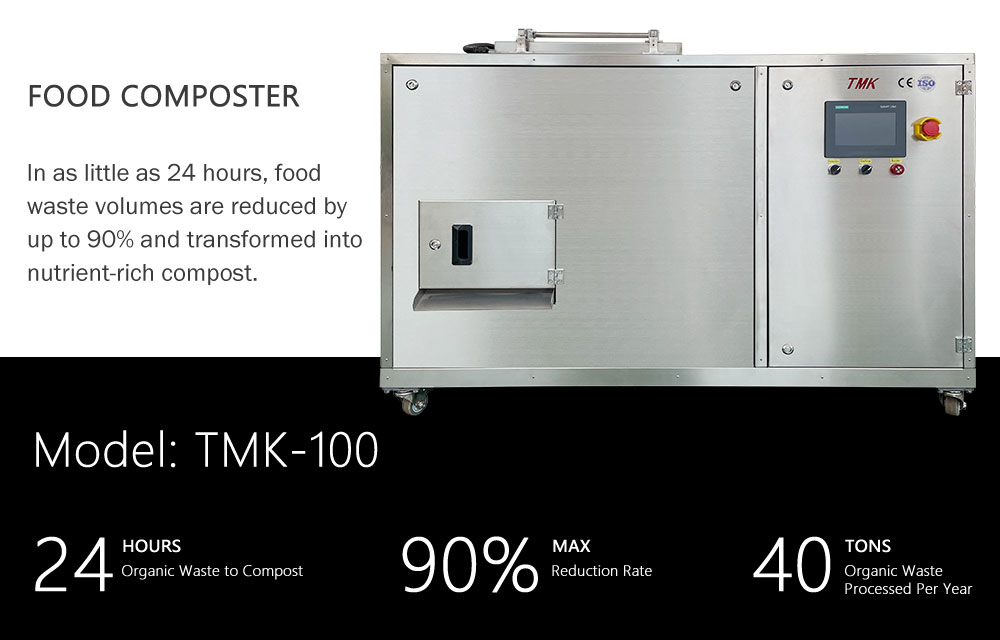A food waste composter machine is a device that processes organic food waste into compost, a nutrient-rich soil amendment. These machines accelerate the decomposition process through various methods, such as grinding, heating, and aeration. They come in different types, including in-vessel composters, composting bins, worm composters, and electric composters. Each type is designed to efficiently break down food scraps, reduce landfill waste, and produce compost to enrich soil and support plant growth. These machines are used in households, businesses, and communities to promote sustainable waste management practices.
Why do we need a Food Waste Composter?
A food waste composter reduces landfill waste by diverting organic materials from disposal sites. It lowers greenhouse gas emissions by preventing the anaerobic decomposition of food waste in landfills. The compost produced enriches soil with essential nutrients, improving soil health and fertility. Composting reduces waste disposal costs for households and municipalities and creates valuable compost that can be used in gardens, farms, and landscaping. It promotes sustainable waste management practices within communities and supports local agriculture by providing a natural alternative to chemical fertilizers. Using a composter educates individuals about environmental stewardship and helps comply with regulations to reduce organic waste in landfills.
Types of Food Waste Composter
- In-vessel Composters: These machines enclose the composting process within a container, controlling temperature, moisture, and aeration. They are efficient and can handle a variety of organic materials, including food scraps, garden waste, and even meat and dairy products.
- Bokashi Bins: This composting method involves fermenting food waste using a special bran inoculated with microorganisms. Bokashi bins are compact, odorless, and suitable for indoor use. They are excellent for processing all types of food waste, including meat and dairy. However, the resulting material needs to be buried or composted further.
- Worm Composters: These use worms, typically red wigglers, to break down food waste. Vermicomposting is efficient and produces high-quality compost known as worm castings. Worm composters are suitable for households with moderate food waste and can be used indoors or outdoors. They do require some care and attention to maintain the worm population.
- Electric Composters: These are compact, electric-powered devices that accelerate the composting process through grinding, heating, and aeration. Electric composters are convenient, odorless, and can produce compost in a matter of hours to days. They are suitable for households with limited space but can be more expensive and require electricity.
Key Factors to Consider
Capacity: Determine the amount of food waste you generate daily or weekly. Choose a composter with a capacity that matches your waste output.
Space Availability: Consider the space you have available for the composter. Indoor units like Bokashi bins and electric composters are compact and suitable for kitchens or small spaces. Outdoor units, such as in-vessel composters and larger worm composters, require more space.
Type of Food Waste: Different composters handle different types of food waste. If you frequently dispose of meat, dairy, and oily foods, an in-vessel composter or electric composter might be more suitable. For plant-based food waste, worm composters and Bokashi bins are excellent choices.
Speed of Composting: The time it takes to produce compost varies between machines. Electric composters are the fastest, producing compost in hours to days. In-vessel composters typically take a few weeks, while Bokashi bins require a fermentation period of about two weeks followed by additional composting or soil incorporation. Worm composters can take several months.
Ease of Use: Consider how much effort and maintenance you are willing to invest. Electric composters and Bokashi bins are relatively low maintenance. Worm composters require regular feeding and monitoring of the worm population, while in-vessel composters might need occasional mixing and monitoring.
Odor Control: Odor is a common concern with composting. Look for machines with good Odor control features. Bokashi bins are known for being odorless, and electric composters often have built-in filters. In-vessel composters with proper ventilation and worm composters with adequate bedding can also minimize Odors.
Environmental Impact: Consider the environmental impact of the machine itself. Electric composters use energy, which might offset some of the environmental benefits of composting. On the other hand, manual composters like Bokashi bins and worm composters have minimal environmental footprints.
Budget: Food waste composter machines vary widely in price. Determine your budget and find a machine that offers the best value for your money. While electric composters and in-vessel composters tend to be more expensive, they offer convenience and speed. Bokashi bins and worm composters are more affordable and environmentally friendly.
Conclusion
Food waste composter is a vital tool for sustainable waste management. By reducing landfill waste, lowering greenhouse gas emissions, and enriching soil with valuable nutrients, it offers significant environmental benefits. Economically, it reduces waste disposal costs and creates useful compost for agricultural and landscaping purposes. Socially, it promotes environmental awareness and supports local agriculture. Compliance with waste reduction regulations and contributions to climate change mitigation further underscore its importance. Overall, investing in a food waste composter is a practical and impactful step towards a more sustainable and eco-friendly future.

